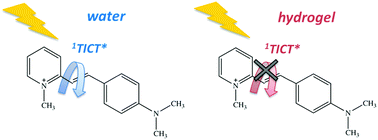Inclusion of push–pull N-methylpyridinium salts within surfactant hydrogels: is their excited state intramolecular charge transfer mediated by twisting?
Abstract
In order to get a deep insight into the environment-dependent photophysics of push–pull pyridinium derivatives, two N-methylpyridinium salts were dissolved within surfactant hydrogels. Surfactant viscoelastic solutions can potentially block or at least limit the torsion of these fluorescent dyes, uncovering the nature of the excited states involved in their deactivation. The excited state dynamics of the two molecules in hydrogels was investigated by means of femtosecond transient absorption spectroscopy, revealing the distribution of the dyes between the hydrophobic domains and the water pools making up the microscopic structure of the surfactant hydrogels. The comparison between the spectral shapes of those transients experiencing an aqueous surrounding and those embedded in the hydrophobic domains allowed the fully relaxed excited state to be assigned to a twisted intramolecular charge transfer (TICT) state. The latter cannot be formed in the rigid hydrogel domains where the excited state charge separation is thus prevented and the stationary fluorescence comes from a scarcely polar locally excited (LE) state.


 Please wait while we load your content...
Please wait while we load your content...